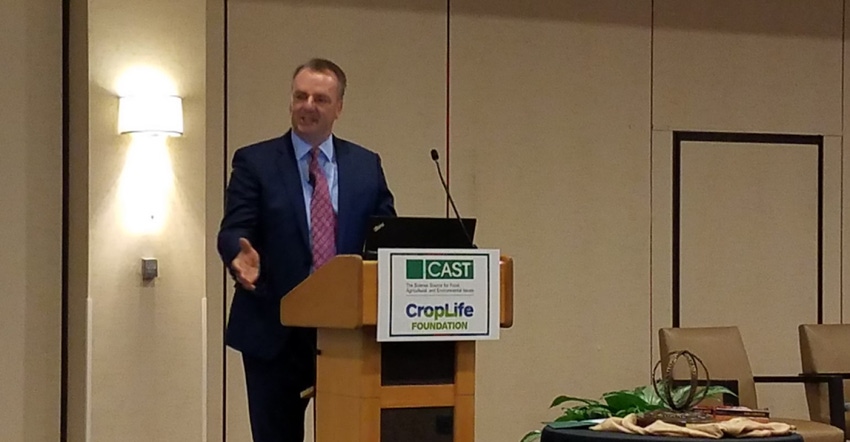CAST Communicator Award recipient Frank Mitloehner discusses opportunities for agriculture to educate on GHG footprint.

A growing number of people think animal agriculture is the number-one contributor to greenhouse gases (GHGs) globally, despite the fact that 78% of GHG emissions stem from human use of oil, coal and gas.
“I have a beef with that,” Frank Mitloehner, 2019 recipient of the Borlaug CAST Communicator Award, said during a side event at the World Food Prize held in Des Moines, Iowa.
Mitloehner, a University of California-Davis professor and air quality extension specialist, said agriculture contributes to 9% of the nation’s GHG emissions, and animal agriculture alone only contributes 4%. People emit more through the transportation sector than livestock do, yet this is not to say that agriculture doesn't matter.
Mitloehner explained that although methane is a pollutant, it is a carbon that cycles through the system, with a cyclical movement of carbon to the atmosphere, to plants and then to animals. Methane also breaks down in a decade, differing from carbon dioxide and nitrous oxide as it is not just generated, produced and emitted but also destroyed.
He did not downplay the role of methane but also said if managed correctly and reduced, it can lead to global cooling. “We can counteract global emissions by reducing short-lived pollutants such as methane,” he added.
“We know we can reduce emissions from animals directly and from their waste. We can achieve drastic reductions; both are necessary, and they are feasible,” Mitloehner said. He said technologies and regenerative steps can help, but it’s important that there is a social license to use those technologies. Research is ongoing on reducing methane on the front end as well as using technology such as anerobic digesters.
Food loss and food waste are other areas where agriculture can make major changes, Mitloehner said of the 40% of food grown domestically, as well as around the world, that goes to waste.
Production efficiencies
The U.S. has one of the most efficient livestock systems around the world, which Mitloehner attributed to improved reproduction, a veterinary system that helps prevent diseases, improved genetics and feeding more energy-dense diets. Dairy production in the U.S. has dropped from a previous high of 25 million cows to now just 9 million cows while producing the same amount of milk. Meanwhile, there are 117 million dogs and cats and 9.5 million horses.
“Why is nobody talking about this? This is not some PR [public relations] stunt; this is the truth,” Mitloehner said. “This is what we need to achieve globally.”
Mitloehner said some people would like to see a return to the production methods of the 1960s, but he warned that doing so would lead to disaster. For instance, going back to slow-growing chickens would be a nightmare, because “we would have to double our flocks,” he said. Societal drivers are pushing for that action. “If we don’t watch them, some people will enact them,” he said.
In order to conquer the 2050 challenge of tripling the current world’s food supply, Mitloehner said, “We have to bring to bear all means necessary, and possible, to enhance agricultural production while not depleting natural resources.”
Telling the story
“We are the envy of the world in how we produce food in this country, and we better tell our story and tell it right,” Mitloehner said.
He said it’s important to speak in terms relatable to consumers. For instance, they can relate to cars on the road or the equivalent of removing X or improvements in fuel efficiency as they relate to productivity improvements.
“It’s time for us to explain in ways the public understands, because they currently do not,” Mitloehner said.
Carl Winter, a past recipient of the CAST Communicator Award and cooperative extension specialist at the University of California-Davis, added that it’s important for scientists to get out there and communicate better. He recognizes that there are a lot of barriers to allowing scientists to adequately describe the issues they care passionately about.
“We need to find ways to incentivize what we do as well as providing training on how to develop these skills,” he said in regard to communicating to the masses. He also said it is short-sighted to not allow scientists at food companies to communicate results.
Channapatna Prakash, past CAST Communicator Award recipient and dean of the Tuskegee University College of Arts & Sciences, added that there is a lot of anti-science and pseudoscience rhetoric circulating today. “Young scientists must learn how to play this game. There’s a lot of people opposed to science and agriculture, and they know the power of social media and are masters of that,” Prakash said. He also encouraged young scientists to be “thick-skinned,” because sometimes it is a very dirty game trying to use science speak and insert reason into current discussions.
Prakash said his Twitter account (@AgBioWorld) encourages followers to come for the cat videos and stay for the science.
In the end, Mitloehner said it all comes back to finding ways to communicate better. “I’m not talking PR but, rather, fact-based information packaged in a way the public can understand,” he said.
About the Author(s)
You May Also Like



.png?width=300&auto=webp&quality=80&disable=upscale)

